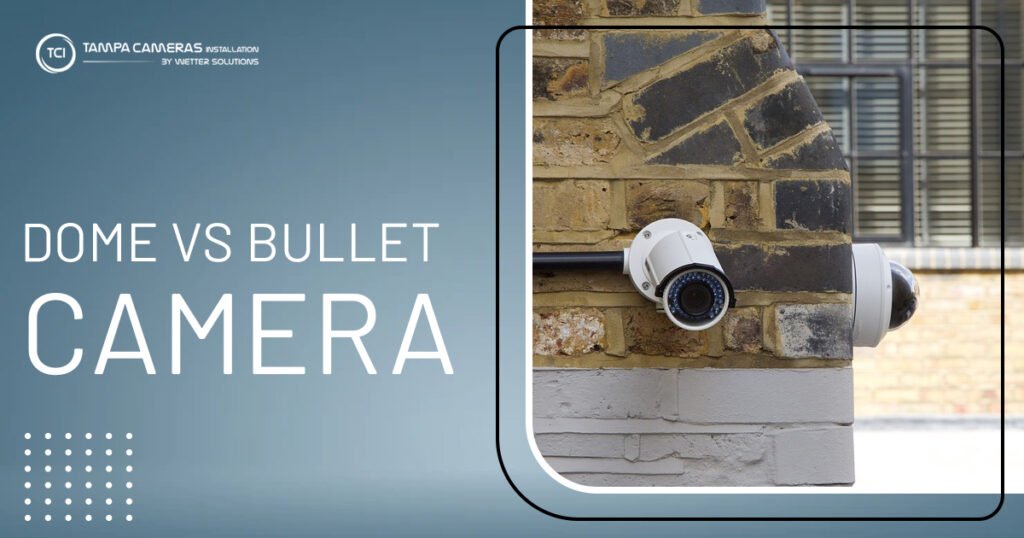The issue between Dome vs bullet camera is usually a contentious one. After you have made the decision to build a security system, one of the steps that follow is to select the type of camera or cameras that you want to put into place as part of the system. Dome cameras and bullet cameras are the two types of cameras that are used the most frequently. Regardless of the size or sort of property you have, you should be aware of the subtle differences that exist between the two types of security cameras (whether residential or commercial).
This article’s goal is to aid you in making a better informed decision by providing an explanation of the differences between dome cameras and bullet cameras, as well as the positives and negatives associated with each. The range of the camera, the method by which it is installed, and the shape of the camera itself are the three key differences between dome and bullet cameras. Dome cameras have a greater field of vision and are more inconspicuous than bullet cameras because to the protective dome shell that surrounds the camera in a dome camera. Bullet cameras project outward from the wall and can only be aimed in one direction.
What kind of camera is a dome?
These security cameras’ spherical, dome-like form gives them their namesake. A protective dome that is see-through surrounds the surveillance camera from all sides. Even though we may install dome security cameras indoors or outside, the sensitive nature of these cameras has led many establishments, like hotels, restaurants, and retail stores, to install them indoors.
Lets take dome vs bullet camera discussion further. The dome-like design of a dome camera is where the term “dome camera” originates. These surveillance cameras are built to resist any environment, whether we install them indoors or outside. As a result of their design, the camera can function well even in environments with little or no available light, thanks to infrared LEDs. The footage captured by a camera may be seen at any time by its owner because all cameras can transmit video signals over the internet. The following is a list of benefits associated with installing dome security cameras.
One of the primary advantages of a dome camera is that it is sometimes difficult to tell in which direction the camerapoints since the dome covers the lens. In addition, because the camera lens shield in a dome camera, these types of cameras are often more robust and resistant to damage. There are also dome cameras designed to withstand vandalism called vandal-proof dome cameras. We set these cameras in tough coverings that are generally resistant to damage. In contrast, bullet cameras may either manually adjust or knock off their mounts to point in a different direction. In contrast to bullet cameras, which can only aim in one direction, dome cameras have a form and design that enables them to monitor a larger field of view thanks to a lens that can be rotated.
Critical Benefits Associated with Dome Cameras:
More unobtrusive; mixes in with the surrounding environment
The camera can rotate and has a wide angle
Vandal resistance
Indoor & outdoor usage
Unaffected by the Weather Night Vision
What does “Bullet Camera” stand for?
The distinctive design of a bullet camera, which resembles a lipstick tube or a bullet casing, is another reason why these cameras are called “bullet cameras.” Bullet cameras, which are one of the most prevalent types of security cameras, have the advantage of being highly visible. Research has shown that installing security cameras will decrease the desirability of your house as a potential target. Bullet cameras, like dome cameras, can be mounted inside and outside of a building.
When it comes to range between dome vs bullet camera dome is a game changer. The range and ease of installation of bullet cameras are two of their primary advantages. As a result of their more excellent range, bullet cameras are particularly well-suited for monitoring expansive areas such as backyards and parking lots. Additionally, bullet cameras are simpler to install, and due to the form of the camera’s body, larger lenses may be attached to the camera without compromising its overall appearance. The tip of the bullet camera has a little lip that acts as a shield against glare and other elements of the environment, making it an excellent choice for usage outside.
The Primary Benefits of Using a Bullet Camera Are:
Longer range
Simple in terms of assembly
Indoor & outdoor usage
Weatherproof
Seeing in the dark
Installation is the primary differentiating factor between dome vs bullet camera.
Dome cameras may be hung from the ceiling or installed on the wall. We cancan use these cameras either inside or outdoors. Dome security cameras are less noticeable than bullet security cameras, but they are marginally more challenging to install. This difference is insignificant, though. If you wish to adjust the field of view on a dome camera, you must remount the camera. On the other hand, you can often relocate a bullet camera (assuming the region you want to watch is within the camera’s range).
Bullet cameras are usually positioned on the side of the wall and can be installed either inside or outside the building. Because they come with a mounting handle already attached, bullet cameras are much simpler to set up. After the camera has been mounted, you can very quickly adjust the lens to point in the direction you want it to monitor.

Camera Range
The range of a camera may be affected by a number of factors, some of which include its sensor chip, the type of lens it uses, broad dynamic range, lines of resolution, and backlight adjustment. Dome cameras, on the other hand, often have more compact lenses than bullet cameras since the design of a bullet camera makes it simpler to house a bigger lens. However, this is something that will rely much on the specific camera that is selected. As a consequence of this, bullet cameras are preferable in settings that call for a camera with a more excellent viewing range.
Light
We must consider light for the dome vs bullet camera debate. The availability of light is typically one of the essential aspects to consider when purchasing a camera; however, the good news is that dome vs bullet camera sometimes feature infrared LEDs, ensuring that light is not as significant of an issue. The cameras are equipped with infrared LEDs, which allow them to function even in dimly lit environments.
Making the Decision Between Dome vs Bullet Camera
When choosing security cameras for your home, it is essential to have a solid understanding of the distinctions between dome vs bullet cameras, even though these variations are pretty minimal. The common opinion is that bullet cameras are the way to go if you want overt security, to send a message to would-be invaders that you have security, and if you want to convey a message that you have security. However, the most effective security systems typically incorporate a combination of dome and bullet cameras. This allows you to watch your property from every possible vantage point inside and out.
In addition, a few components are essential to both cameras, and you need to consider those aspects as well. Infrared (IR) technology, wireless connectivity as opposed to cable, and night vision are three essential elements of modern security cameras. The majority of the dome and bullet security cameras sold by Swann come equipped with infrared (IR) thermal detection and night vision, allowing you to keep an eye on your property at all hours of the day and night. In the article titled “Types of security cameras,” our team of security specialists explains each of these characteristics in further detail.
Diversity, as well as adaptability
The dome security camera provides a number of options regarding the camera’s form, size, and angle of view. Some cameras have excellent night vision, while others include motion sensors and pan-tilt-zoom capabilities. Still, others have all three. These cameras may be installed virtually everywhere, from intersections to parking lots to the private property of an individual’s garden. Dome cameras have the ability to cover enormous areas, which is a prominent selling feature for these types of cameras. The dome camera’s enormous field of view not only maximizes the viewing area but also enables the camera to function as a panoramic surveillance camera when combined with the appropriate sensors.
Discreetness
Dome security cameras are typically invisible because of their understated and straightforward designs. Many users choose to put these cameras at front entrances, churches, or other locations where guests might be surprised to find themselves under watch. When attempting to avoid vandalism, the low profile aspect comes in helpful as an additional defence mechanism. There are dome security cameras resistant to vandalism, but even for those that aren’t, the design is so stealthy that it deters specific criminal activity. Because the camera’s lens is shielded, it is more robust. People are not typically able to tell in which direction the lens of the camera is pointing, which contributes to the camera’s stealthy style and may hopefully deter potential criminals by creating a sense of uncertainty in them. The simple cameras can blend in with their surroundings, giving the impression that the security system is less intrusive.
The Benefits of Using Bullet Cameras
Bullet cameras get their name from their distinctive cylindrical form, similar to a bullet’s shape. Research has shown that the presence of bullet cameras makes a property less desirable to a criminal. These cameras serve as a visible deterrent, and the presence of these cameras makes a property less desirable.We can use these cameras inside and outside, and they have features such as a small lip on the tip of the lens to protect them from any glare or other weather conditions. The primary benefits of putting in a bullet camera are outlined in the following paragraphs.

